
|
Home DH-Debate 45. Oluf 2. |
Margrete was the youngest daughter of Valdemar Atterdag and Queen Helvig. In 1359, at the age of 9 - 10 years old, she was married to King Håkon of Norway, who was then 19 years old. In Norway, she was placed in the care of a daughter of the Swedish saint, Birgitta of Vadstena, until she was old enough to live with her husband. In 1370 she gave birth to his son Oluf, who was to become king of both Norway and Denmark.
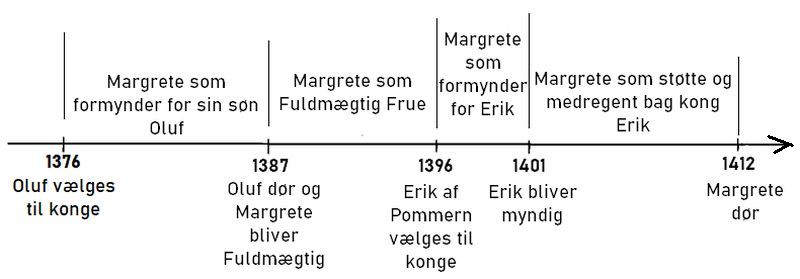
Timeline showing the different periods in Margrethe 2's reign as regent of Denmark.
She ruled as official head of state in Denmark only in the period 1387-1396, during which time she had the title: "Ruler and guardian of the kingdom of Denmark". But we remember her as "Queen Margrete".
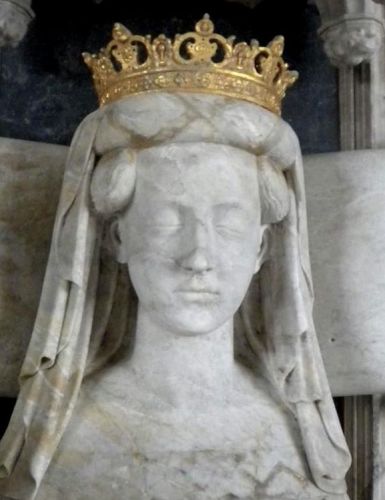
The figure does not look like a 59-year-old woman and most likely there is no portrait likeness. She was born in 1353 as the youngest daughter of king Valdemar Atterdag and his queen Helvig. She died in 1412 on a ship in Flensborg Fjord. Foto Jacob Truedson Demitz assisted by Emil Eikner for Ristesson - This image comes from the Southerly Clubs of Stockholm - Wikipedia.
However, her actual reign was much longer, since she ruled in Denmark already from 1376 as effective guardian for her son Oluf until his early death in 1387. In 1396 she had the 14-year-old Bugislav elected as king of Denmark, Norway and Sweden under the name Erik of Pomerania, being Valdemar Atterdag's great-grandson through his eldest daughter Ingeborg and her daughter Maria of Mecklenburg. Margrete remained the nominal ruler of the kingdoms until Erik was declared of age in 1401. But even after that, Margrete continued to have a firm hand in the kingdoms rule until her death on Flensborg Fjord in 1412.
Margrete 1. is known for having united the three Scandinavian kingdoms, Norway, Sweden and Denmark, which in practice already happened in 1389 after the victory over King Albreckt in the battle of Falköbing, which is located between the two large Swedish lakes. When Erik of Pomerania was crowned king of these three kingdoms in Kalmar in 1397, the association was named the Kalmar Union.

|
Denmark's kings divided into Dynasties. However, all the kings - apart from Magnus the Good - are descended from "Hardegon, son of a certain Sven", who conquered a large part of Jutland around the year 917 as reported by Adam of Bremen in the section on bishop Hoger. The succession of kings and years of war and peace are the backbone of history - not that accounts of culture and the living conditions of ordinary people are not important - but without the succession of kings, history can easily turn into a kind of unstructured fireplace chat about aspects of Denmark's history that cannot be easily fixed in memory. It benefits clarity to divide the royal succession - and thus the history of Denmark - into clear sections.
The Knytlinge family got its name from a Hardecnudth, who was probably the son of Sven. He is also called Knud 1. and was with great certainty the father of Gorm the Old, as told by Adam of Bremen in the section about Bishop Unni.
Magnus the Good, who became king in 1047, was the son of the saint king Olav of Norway; his reign is a period of transition to the time of Sweyn Estridsson and his sons and grandsons.
The rival kings, Svend, Knud and Valdemar, from 1146 to 1157, were all descendants of Sweyn Estridsson; their time forms an interregnum to the Valdemars' period.
Many historians, most likely most, consider only Valdemar the Great and his sons, Canute the Sixth and Valdemar the Victorious, to be Valdemars. But no one can have a patent on this definition, and it seems pedagogically advantageous to the author to also include their less successful descendants - which are Erik Ploughpenning, Abel, Christoffer 1, Erik Klipping, Erik Menved and Christoffer 2. who was the last king before the kingless time.
Valdemar Atterdag recreated Denmark and thus the possibility of the Kalmar Union with Norway and Sweden, one might say - with a little good will. His daughter Margrete 1. became queen of the Scandinavian Union.
The first Oldenborg kings were also Union kings - but only for shorter periods.
The civil war, the Count's Feud, in 1534-36 was a turning point in Denmark's history. The Lutheran Reformation took place at the same time, and allowed the kings to confiscate the third of Denmark's agricultural land that belonged to the church. This fabulous wealth made it possible for them to cow Denmark's old nobility and after some time to establish the autocracy that coincided with Denmark's historical decline. In 1848 a democratic constitution was introduced with no civil war or other violent events.
The Oldenborg royal family died out in 1863 with the childless Frederik 7. After that, Christian 9 of Glücksborg became king.
In the Middle Ages, it was not unusual for kingdoms to be led by women. Margrete could be inspired by two great role models in Danish history, namely Christoffer 1's dowager queen Margrete Sambiria in 1230, and Erik Klipping's widow Agnes of Brandenburg in 1286.
But it must still have seemed almost surreal at the time that in the late autumn of 1375, very shortly after Valdemar Atterdag's death, a slender 22-year-old woman appeared in Denmark with her little son and demanded to be titled as Queen of Denmark, Norway and Sweden, although she was only Queen of Norway. This unprecedented self-confidence in a woman can of course have been due to innate personal qualities, but must also be attributed to the fact that she was brought up in Norway under the strong influence of the Swedish saint, Birgitta of Vadstena, who promoted a more prominent role for women in Christendom.

Valdemar Atterdag was the son of the last of the Valdemars, Christoffer 2. but he represents a new beginning, a new dynasty. He was the returned king. He gathered the sad remains of a Danish kingdom and rebuilt the mation. Many new things came about during his reign. It is in his time that we first hear that the people are made up of different estates "Knights and armsmen, ladies and maidens, merchants, guests, peasants and workmen" and in his reconstructed kingdom the difference between kongelev and patrinomium disappears, that is the difference between the estates that belonged to the royal office, and the estates that were the royal family's private property.
Valdemar's grandson Oluf 2. was the son of the Norwegian king and at the same time of the Swedish royal family. He had the potential to unite the three Nordic kingdoms, but unfortunately he died early.
At Valdemar's death in 1375, Oluf was elected king of Denmark with his parents, King Håkon of Norway and Margrete, Valdemar's youngest daughter, as guardians. Upon King Håkon's death in 1380, Margrete also became guardian for Oluf in Norway. Upon Oluf's early death in 1387, she was named "Ruler and guardian of the kingdom of Denmark". Shortly afterwards she obtained similar titles in Norway and in 1388 also in Sweden. We remember her as Queen Margret 1.
In 1396, she adopted her late sister's grandson and made him king of the three Nordic countries under the name of Erik of Pomerania with herself as guardian while he was a minor. But to the detriment of the Nordic unity, first the Swedish council and then the Danish council renounced fidelity and allegiance to him in 1439 and he withdrew to Gotland and later to Pomerania.
Then Christoffer 3. of Bavaria became king of the union in 1440. He was the son of Eric of Pomerania's sister, Katarina, and thus great-great-grandson of Valdemar Atterdag. He was a flexible politician who could make the councils of the three Nordic countries to cooperate, but unfortunately he died childless after only eight years.
In the critical teenage years, which are so important for the formation of attitudes, Margrete was brought up by the holy Birgitta's daughter, Merete Ulfsdatter, who was a conscientious Christian folowing to her mother's instructions, but also an unwavering supporter of the Swedish king Magnus Smek and his son, the Norwegian king Håkon, despite Birgitta's accusations against Magnus of immoral living.
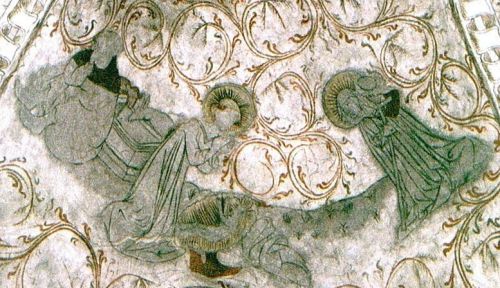
Saint Birgitta of Vadstena sees the birth of Jesus in a revelation on a fresco in Undløse Church south of Holbæk from around 1435. It shows the birth of Jesus in the presence of Saint Birgitta, who is kneeling on the right dressed as a pilgrim with a walking stick.
The picture is based on that Birgitte saw the birth of Jesus in a vision when she was on a pilgrimage to the Holy Land in 1372. In accordance with the recorded revelation, Mary has here taken off her shoes and in a kneeling position worships the child, who lies radiantly on the stable floor. On the left, Josef sleeps with his hand under his cheek and does not witness the miraculous birth, which fits with Birgitta's vision of Josef leaving the stable after tying the ox and the donkey to the manger.
Birgitta had her first revelation when she was seven years old. Since then she got several hundred, all of which were written down by the monks and priests, who followed her everywhere. They are collected in the work "Revelationes Coelestes", which means "Heavenly Revelations", in seven volumes. Photo Wikiwand
At Akershus in Oslo, Mrs. Merete let the young Margrete grow up with her own daughter, Ingegerd. She made no distinction between the girls, she is said to have "used the stick equally generously on both of them".
Margrete also became a great follower of the holy Birgitta. She did everything in her power to make Birgitta's new monastic order a stronghold in the Nordic religious life. One of her first actions in the days after the battle of Falköbing in 1387 was thus to promise the monastery in Vadstena her protection. She worked eagerly to have Saint Birgitta canonised, which she succeeded in 1391.
In 1389, she personally witnessed the admission of two Norwegian sisters to the monastery in Vadstena.
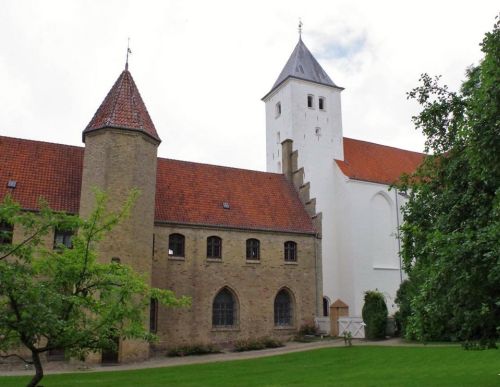
Mariager monastery church and monastery from 1446. Photo Tripadvisor
At Christmas 1403, the queen herself came to Vadstena and requested to be admitted as a sister outside the house. The wish was fulfilled and in the convent's conversation room the queen walked humbly between the sisters and brothers and kissed their hands. A monk modestly covered his hand into the sleeve before holding it out, but the queen brushed the sleeve aside, saying, "Give me your hand uncovered, I am now your sister."
Margrete worked to establish Birgittine monasteries in Denmark as well, but only after her death the monasteries were built in Mariager 1412 and in Maribo 1416. Both town names can be traced back to the Virgin Mary monasteries of the Birgittine order.
Birgitta worked to raise the status of the Virgin Mary as a model for the Christian person and wrote: "I want to institute this order in honor of my much-loved mother and above all for women".
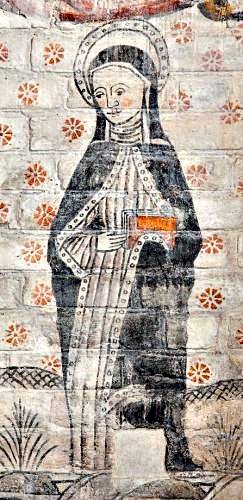
Birgitta af Vadstena in chalk painting in Nibe Church from 1508. Photo Aalborg Stift.
Jesus went up to heaven and said to his disciples: "You have already heard me say that I will leave you and that I will also return to you." But who remained on Earth with all the problems? His mother did.
As a young woman, Birgitta wanted to become a nun, but she was forced to marry at the age of thirteen. She had eight children with her husband, Ulf, in an apparently happy marriage. After Ulf's death in 1344, Birgitta became more religiously active, receiving a revelation in which she was called to be the bride of Christ.
In a revelation in which she witnessed the birth of Jesus, she opened up the possibility of a female savior: "When the shepherds saw him, they first asked if it was a boy or a girl, because the angels had informed them that the male "savior" - not female "savior" had been born. Then his virgin mother showed them the infant's male genitalia".
With few exceptions, Birgitta stays within the Christian tradition, where God and Jesus are men. But instead of seeking to make the masculine powers feminine, Birgitta uses the feminine Virgin Mary, elevating her to their equal.
As Adam and Eve are of the same flesh, since Eve was made of Adam's rib,
then Jesus and Mary are also one flesh with Birgitta, as they share the same heart. In a revelation, the Virgin Mary says "I am the Queen of Heaven. You were worried about how to praise me. Know for sure that all praise to my Son is praise to me. And those who dishonor him dishonor me, as my love for him and his for me is so burning that we two were like one heart."
With Birgitta, Mary and Christ are equal about the salvation, just as Adam and Eve are equal about the sin.
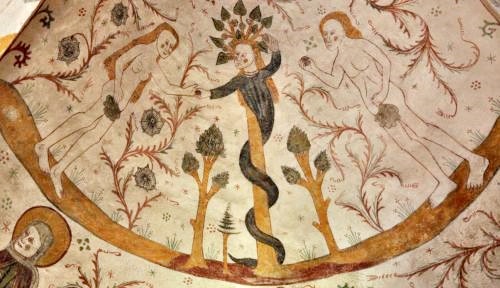
Chalk painting showing the Fall from around 1500 in Tingsted Church on the island of Falster. Photo Aalborg Stift.
The Bible's book of Genesis is traditionally interpreted as if it was the woman who sinned and then enticed the man: "The woman saw that the tree was good to eat from and attractive to look at, and that it was also good to gain insight from, and she took the fruit and ate. She also gave it to her husband who was with her, and he ate." But Birgitta emphasizes that they committed the sin together, and she rejects the idea that the woman is weaker and less resistant to temptation.
She did not put the intellectual Mary on a pedestal compared to the practical and diligent Martha, as Jesus does in the Bible. In a revelation, she let Jesus say: "Remember that Martha prayed for her brother Lazarus and was the first to come to me, even though her brother was not raised immediately. Mary was called afterwards, and then their brother was raised to life for the sake of both sisters. Thus it is in the spiritual life. She who really wants to be Mary must first be Martha and work physically for my glory." After all, Birgitta herself had been a practical housewife with eight children.
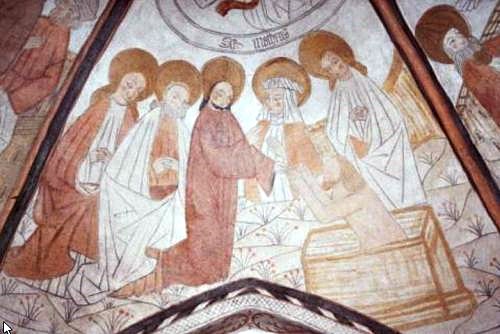
Chalk painting of the raising of Lazarus from the dead from 1475 in Ejsing Church between Skive and Holstebro. Photo Kalkmalerier.dk.
Birgitta emphasizes that physical virginity is subordinate to spiritual virginity, which last means that one is pure in the soul: "Virginity is good and the most excellent, because it resembles the angelic state, provided it is maintained with wisdom and virtue. But if the one is lacking from the other, that is, if there is virginity of the flesh but not of the mind, then virginity has been deformed. A devoted and humble housewife is more acceptable to me than a proud and immodest virgin."
Birgitta highlighted the personal faith in that she believed that the individual must acquire the the story of the salvation themselves. She wanted people to be able to read the Holy Scriptures in their mother tongue. If the people did not understand the scripture, they could not be elevated and learn from it, as Luther later said. Therefore, she ordered parts of the Bible translated into Swedish. In Vadstena, services were often held in Swedish.
She criticizes the church and the nobility for having apostatized from the right faith and thereby neglected Christ. In a revelation, she compares Christ to a bridegroom and the people to a bride. The church is the marriage chamber where the two must be united. But the bride has turned against her bridegroom and has become a harlot: "But now your bride has become an adulteress. The chamber doors are closed, and instead of a bride, there lies an evil adulteress thinking to herself: "While my husband sleeps and lies there naked, will take a sharp sword and kill him, for he does not please me."
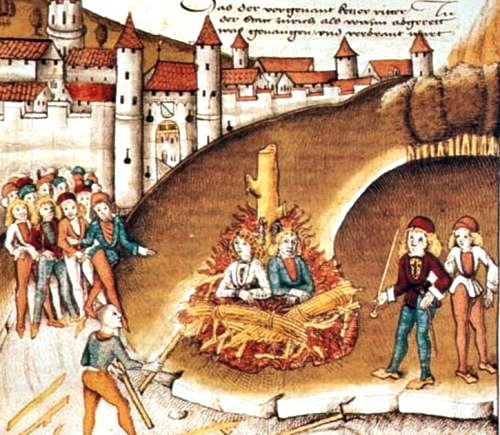
Two men, Richard Puller von Hohenburg and Anton Mätzler, were accused of sodomy and burned on the stake in Zürich 1482. From Diebold Schilling der Ältere (1430-1486) in Grosse Burgunder Chronik (Zürich).
The Bible's Third Book of Moses verse 13 is quite clear about the punishment for male homosexuality: "If a man has intercourse with a man as one has intercourse with a woman, both of them have committed an abomination. They shall suffer death. They have himself to blame for their deaths."
There were certainly far more homosexuals than there were witches in the Middle Ages, but despite the clear words of the Bible, burning of homosexuals never really came to fruition. The author knows of only two cases. Foto Wikipedia.
It is said that the Danish historian Frederich Hammerich suggested in 1862 that Birgitta was a harbinger of the Reformation because of her sharp criticism of the clergy and the church, her insistence on personal faith and her political appeal.
Birgitta's accusations against King Magnus of homosexuality were in all probability the most important reason why the Swedish nobles rose against him and put Albreckt of Mecklenburg in his place. His nickname "Smek" is inspired by Birgitta's accusations, as it means "cuddly".
Birgitta mentions that Magnus and Queen Blanche had agreed between themselves that they should be mutually sexually abstinent for a time. Birgitta criticized this, because in her opinion the king had done it because of a new unmentionable passion. She also mentions the risk that this agreement could give rise to slander.
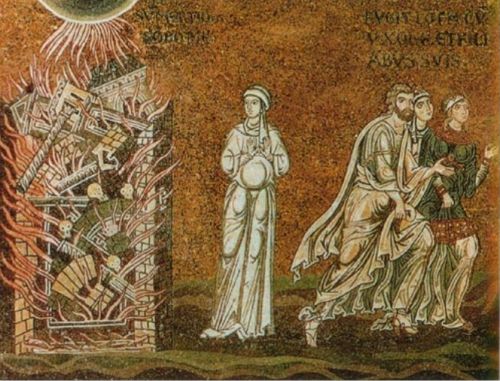
The destruction of Sodom and Gomorrah because of the vices of the inhabitants. Lot and his daughters escape, but Lot's wife looks back and turns into a pillar of salt. Painting in Dom von Monreale, Sicily. Thomas Aquinas gave a definition of the vice of the inhabitants, "sodomy", in his Summa Theologica. He wrote: "By intercourse with an improper sex, man with man or woman with woman, as the Apostle Paul says: (Romans 1:26-27) and this is called "sodomy". Photo Lysis dkwiki.dk.
Queen Blanche and King Magnus were both close friends of Magnus' favorite, the young Bengt Algotson, to whom the king - against the laws of the country - gave a lightning career, squire in 1350, knight in 1351, councilor in 1352 and duke of Halland and Finland in 1353. It also annoyed the Swedish noblemen that Magnus appointed many other rather unknown young men as bailiffs and commanders.
Birgitta chastises people for homosexual activities. According to her, there is a sin in the kingdom of Sweden that is more heinous than the others, because it incites man to a lust that is against nature itself. Over time, she became more direct in her criticism of King Magnus, accusing him of loving men more than his wife: "You have the worst reputation in the whole kingdom. It is said that you practice intercourse and perversion with other men against nature. This seems probable, since you love some men more than God, or your own soul, or your own wife."
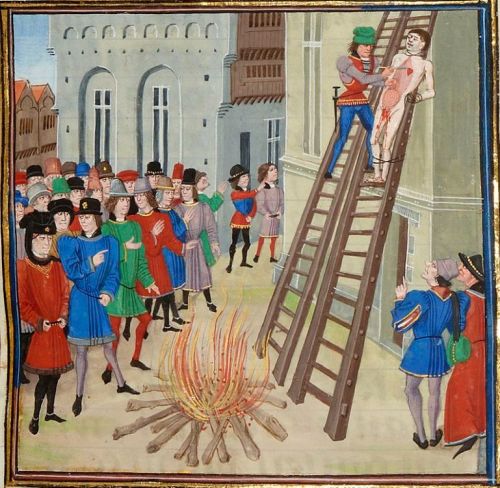
In England in November 1326, Hugh Despenser was sentenced to death for treason, hanged from a height of 16 meters; then, before he was completely dead, cut down from the gallow, eviscerated and beheaded. Despenser's genitals were cut off because he was a heretic and a sodomite, even, it was said, with the king. His head was displayed on London Bridge and his body was cut into four parts, which were displayed in the populous cities of Bristol, Dover, York and Newcastle. The king in question was Edward 2. and Despenser's death occurred only a few weeks before his deposition. Within a year, Edward himself would be dead, allegedly as a result of the insertion of a red-hot iron rod into his anus. From a manuscript by Jean Froissart. Photo Loyset Liedet Wikipedia.
Nor did Birgitta keep her fingers crossed in relation to the Pope. In her accusation against Clement 4. she speaks with the voice of Christ: "Now therefore I accuse you, you head of the Church, you who sit on my chair, the one I left to Peter and his successors to sit on with threefold dignity and authority" - "You are worse than Lucifer" - "You not only kill me, but with your evil deeds you drive me away from you, you also kill the souls by your bad example." - "You are more unjust than Pilatus. He only sentenced me to death, but you are not only judging me, no, you are also judging the innocent souls."
Sjælland Chronicle: "In the year 1353, the queen gave birth to a daughter, who was baptized by the venerable father Bishop Henrik of Roskilde and called Margrete." Since this is mentioned at the beginning of the chronicle, one can guess that the birth occurred first in the year.
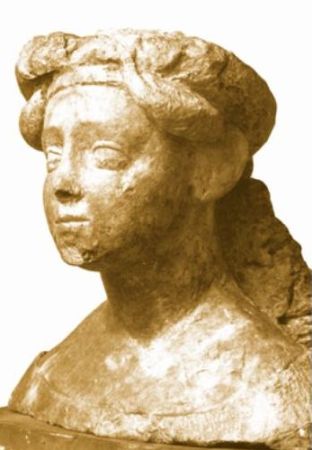
Portrait bust of Queen Margrete from about 1420. Presumably a preliminary study for her sarcophagus in Roskilde Cathedral. Cast of the original alabaster bust owned by the Sankt Annen Museum in Lübeck. Photo Wikiwand.
Queen Helvig had previously given birth to a daughter who had been named Margrete, but who unfortunately died early. Margrete was the name of King Valdemar Atterdag's older sister, who as duchess of Bavaria had taken care of Valdemar when he was sent to the imperial court in Berlin as a boy. Perhaps it was important for Valdemar to remember her.
After Valdemar's victory in the First Hanseatic War, the marriage between Margrete and King Håkon of Norway became relevant again, and the wedding was celebrated on 9 of April 1363 in Copenhagen. The Scanian Yearbook reports that "King of Norway, Håkon, married Margrete, daughter of Valdemar, King of Denmark, and a solemn wedding was celebrated in Copenhagen, where Archbishop Niclaus celebrated his first mass."
The holy Birgitta virtually banned ten-year-old Margret's marriage to Håkon of Norway, writing that "it was child's play with dolls, she is of banned seed and younger than the church laws allow, no salvation can ever come from her offspring". Birgitta likened Valdemar Atterdag to a wolf, just as she called the old duke Albreckt a fox.
The expression "banned seed" testifies that she hated Valdemar and his entire family (because he had taken the Scanian lands back to Denmark). It must have made a great impression on the young Margrete, since in other respects she obviously had great respect and faith in Saint Birgitta's visions of the exaltation of the Virgin Mary and a more important role for women in Christendom.
You have to believe that a young person who grows up with such a label on her will develop a certain toughness and readiness for conflict, an awareness that "I know they don't like me, but I just don't care". She or he will not break down easily when faced with resistance, because she has expected that all along.
Unlike Birgitta, Margrete loved and admired her father, Valdemar Atterdag. When she landed in Denmark in 1375, she initially called herself "queen of Denmark, Sweden and Norway", but later she preferred the title, "Margrete, daughter of Valdemar Daneking". She zealously persecuted the nobles, who had rebelled against her father.
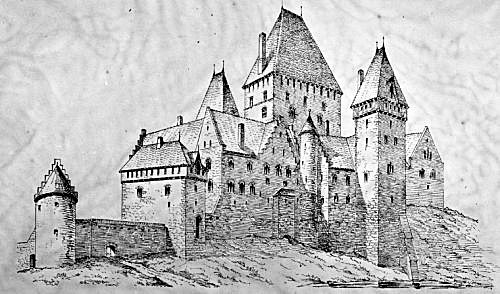
Akershus castle in Oslo. Restoration draft of Akershus castle seen from the south-east. Poto: Drawing by Severin Worm-Petersen 1909-1920. Norsk Teknisk Museum.
The little Margrete was brought to the fortress Akershus at the bottom of the Oslo Fjord, where she was brought up by Mrs. Merete Ulvsdatter, who was the daughter of the holy Birgitta. In contrast to Birgitta, Merete and her husband, Knut Algotsson, were faithful followers of Magnus Smek and his son, King Håkon.
A monastery chronicle tells that Margrete and Mrs. Merete's own daughter, Ingegerd, were brought up strictly, and she did not differentiate between the girls - "often they got to taste the same stick".
But as the historian Erslev wrote "it would have been better if it had been disclosed what the upbringing consisted of." But Saint Birgitta's mission was to give women a more prominent place in Christendom, therefore we must believe that she unlike many other women of the time received some education.
When Margrete was fifteen years old, she and Håkon began living together as a married couple and she was pregnant when the plague haunted Oslo for the third time in twenty years in 1369.

Excerpt from Margrete's emergency letter to King Håkon. Photo Arkivverket.
Despite her young age, the queen already appears in 1369 as a mature and determined woman. A letter from her hand to Håkon has been preserved - often quoted by historians - in which she says that she is well and she hopes that her husband can say the same, but that she and her servants can no longer eat their fill, she asks the king to arrange for her to get credit with the Hanseatic merchant Westfal. She also asks him to pardon two exiled men, which she had promised them:
"To you, my dearest Lord, I, Margrete, sincerely greet you with God. I can tell that I am well. God let me hear the same with you. You must know, my dear Lord, that I and my servants are in great want of food and drink, so that neither they nor I get our necessities. And therefore I ask you, my dear Lord, that you can find some way to make it better so that those who are with me will not be separated from me because of hunger. And I ask you to write to Westfal that he can give me what I can demand from him and need, and tell him that you will pay him what he gives me. And if you want to write to him about this, then also write a letter to me about what you are writing to him. I still ask you to satisfy Hans Mintmaster in such a way that he can remain in your service and not be separated from you, for I have understood from him that he is happy to be willingly at your service, that if you come to terms with him, then arrange I saw with him that he can lend me if a ship were to come here, and write me an answer about that as well. Likewise, I announce to you, my dear Lord, that I received Bartholomæus Goldsmith's letter, in which he asks me to apologize to you for not coming to you, as you wrote him to, for the reason that if he had gone to you, then the ship had sailed from him with all the goods that he had to pay in Flanders, and he asked me to tell you that he intends, with God's help, to come again before the winter, and what he has brought here you must be in charge over as much as you please. And therefore do well for God's sake and for the sake of my appeal and do not be impatient with him, nor Gaute Erikssøn, because he could not be ready to travel sooner. God be with you, my dear Lord. Written at Akershus saint Lucas the Evangelist's Day. (18 oktober).
Underneath, she has added a postscript in which she asks for pardon for two criminals: "And I have promised Mr. Henrik that I will write to you that you will do it for the sake of my appeal and not give Ketil af Hoffland or his companion exile".
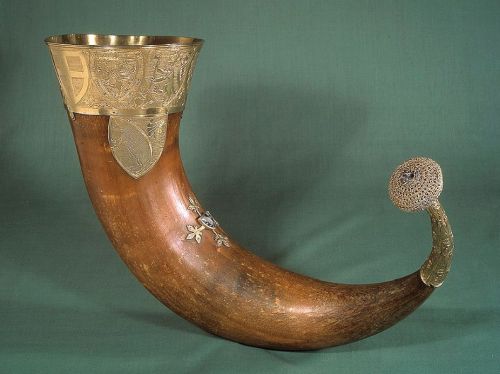
The Norwegian royal horn from the 14th century, Queen Margrete's time at Akerhus. It is made of an aurochs horn, 17 centimeters in diameter and 49 centimeters long, and with a length of 89 centimeters along the curvature. Note that it has no foot. It is intended to be emptied immediately when the bowl is called. Photo Lennart Larsen - National Museum of Denmark - Wikipedia.
At Christmas time 1370, she gave birth to her and Håkon's only child, who was named Olav after the Norwegian saint king, Olav the Holy.
In February 1376 - three months before the election of Oluf as king in Slagelse - Anders Jepsen Lunge and Drost Henning Podebusk, on behalf of Queen Margrete, presented a proposal for peace between her husband, King Håkon, and the Hanseatic League, and at the same time she promised to confirm all the cities' privileges in Denmark.
An internal letter in the Hanseatic League reveals that the merchants did not fully trust Margrete's promises: "Now we are very surprised that the aforementioned king has not himself sent any letters or promises, because it seems to be a big deal to place trust in the lady and turn to her". Perhaps they had also noticed that she was not head of state in Denmark yet.
During these years, the Norwegian royal family was in a very stressful financial situation. King Håkon had to pledge his crown, which was made of gold studded with precious stones, a golden belt studded with precious stones and his late mother's - Queen Blanche's - gold buckle to two merchants in Stralsund. However, the valuables were redeemed in 1372.
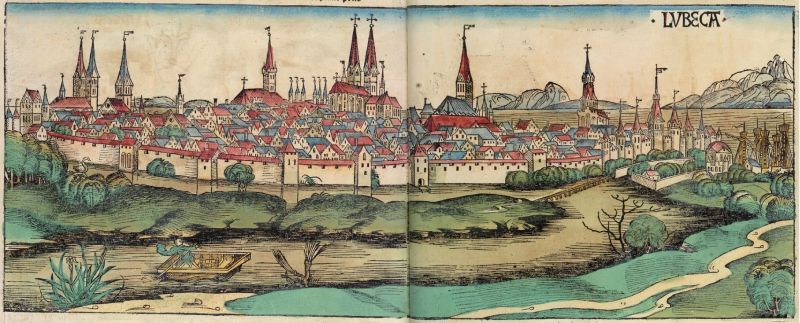
The rich Hanseatic city of Lübeck seen from the northeast in 1493. The oldest depiction of the city from Schedel's World Chronicle. Foto Abbildung aus der Schedelschen Weltchronik (lateinische Ausgabe in Sao Paulo) - Michel Wolgemut, Wilhelm Pleydenwurff (Hartmann Schedel, editor) Wikipedia.
The Detmar chronicle from Lübeck tells that at the beginning of her reign Margrete was such a poor princess "that she could not give a meal of bread without the help of friends".
Right from her early youth, Margrete must have seen herself as predestined for power. When she arrived in Denmark after her father's death in 1375, she called herself from the very start "Queen of Denmark, Sweden and Norway", although strictly speaking she was only Queen of Norway.
She immediately set to work for her son's candidacy. In December 1375, she handed over Holbæk Castle and three Zealand manors to Drost Henning Podebusk for only 400 marks, in return for his seal recognizing her as "Queen of Denmark, Norway and Sweden".
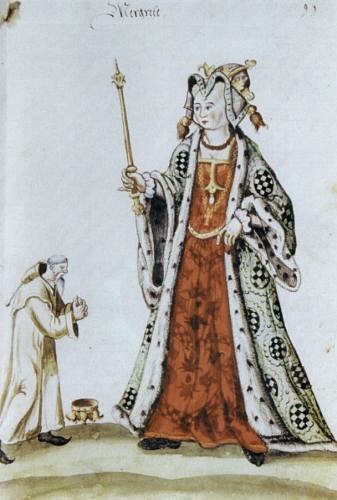
Drawing from around 1800, which depicts Queen Margrete 1. and Albrecht, who loses his crown. It is said that Margrete had a hat with a long tail sewn for Albrecht to mock him. This is perhaps the situation that the artist has imagined. Photo Illumineret Kongerække, 1589. Gl. kgl. Saml. 812 8, Det Kongelige Bibliotek.
But everyone at the time agreed that she was intelligent, although they mostly used the less flattering term "cunning".
The Scanian Yearbook writes that she was elected in 1387 "because of the great wisdom that God has given her".
A Swedish source writes: " Albrecht imposed heavy taxes, but Margrete even harder; what he left, she took, the farmer's horses, ox, cow, in short, all his property," and further "she was very avaricious; with incredible cunning she subjugated three kingdoms, which she brought down to almost nothing, and nobody could resist her cunning"
The Holstein Chronicle from around 1450 writes: "But after the death of King Valdemar, his daughter Margrete (who had a son Oluf with her husband Håkon, king of Norway, and who had taken the crown and the scepter of the kingdom in Denmark) began to rule with great cunning and united the kingdoms of Denmark, Sweden and Norway into one. Because she quarreled with King Albrecht of Sweden, defeated him and kept him in chains for seven years and took the whole kingdom."
The chronicle continues: "this queen, who was a very cunning woman, did not at same time simultaneously light fire in several places."
In The Swedish Karlschronicle, written down in 1440, it is stated:
"Her name was Queen Margareta
one really has to look far
after one who with such cleverness can
these kingdoms to merge:
Sweden, Denmark and Norway.
Late such a woman will be born.
I think the Swedes were not clever,
when they took her as a ruler.
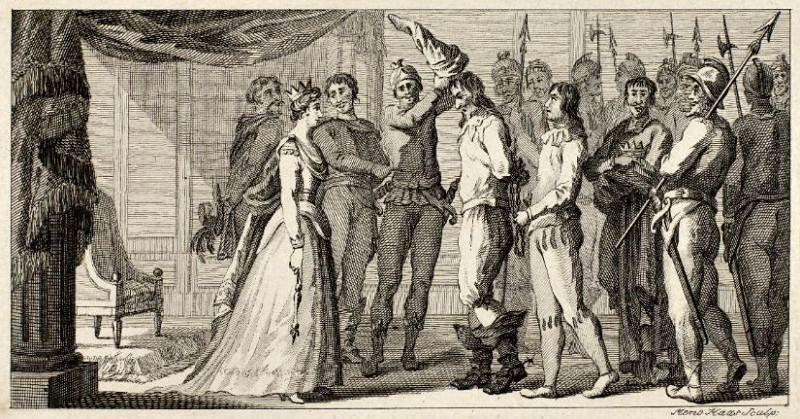
Copper engraving showing Queen Margrete dressing Albreckt in a jester's hat. Done by Meno Haas, who lived from 1752-1833. Meno Haas was German, but grew up and worked for many years in Denmark Foto: Det Kongelige bibliotek, Billedsamlingen.
A Norwegian letter from 1414 is more positive: "She would help everyone to equal justice and law, strengthen justice and suppress all evil, may God reward her."
In his royal chronicle, Chronica Regni Gothorum, from the end of the 1400's, the Swedish historian Ericus Olai wrote that the period of union was an unhappy time for Sweden. Margrete was in every way her father's daughter, just as cunning and calculating as he was. When she had seized power in the country, her government distinguished itself by breaking promises, violating the law, appointing foreign bailiffs and exporting Swedish tax funds to Denmark.
But the Danish Arild Huitfeldt wrote around 1600 - after studying many old documents: "A praiseworthy, shrewd, cunning and wise princess in matters pertaining to management and government. Her master, father, said that nature had lost its way with her. She should have become a man, but became a woman."
Margrete was a tough negotiator. Historian Michael Linton provides an extract from the Hanseatic League's minutes of peace negotiations in 1394, where the merchants demanded compensation for losses they had suffered in Denmark.
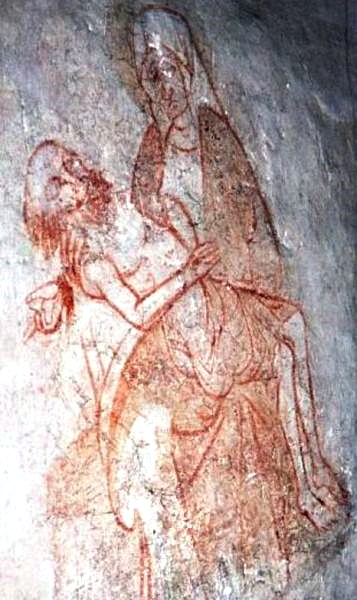
Pieta - Virgin Mary with her dead son. Chalk painting in Tågerup Church from 1400. Foto Kalkmalerier.dk
The merchants: "We have a claim on the goods that are stranded at Helsingborg, and which have a value of 214 grotes" (money in gold).
Margrete: "It was in Henning Podebusk's time. We have nothing to do with this, since he ruled Scania on behalf of the cities."
The merchants: "Henrik Parow, commander at åsle had a debt of 600 nobles."
Margrete: "It dates from the time when Mr. Parow was an enemy of the kingdom."
The merchants: "A Prussian merchant has been robbed of goods to the value of 11,512 nobles" (a huge amount).
Margrete: "The goods have been taken to Mecklenburg".
The merchants: "A Danish castle commander has taken a ship with wine".
Margrete: "He has taken that to Stockholm to the delight of the kingdom's enemies".
The merchants: "We have an old claim from one of us, amounting to 411 nobles."
Margrete: "The bishop in Aarhus, Jens Andersen, must give him 100 nobles, we ourselves 10."
Queen Margrete preferred to rule by brute force and to the least possible extent be bound by laws, contracts and agreements. However, not so that she was inclined to solve problems with physical violence. She preferred the cool game of the bargaining table, where the pieces were her devoted followers, her financial power, and the military power that this wealth allowed her to bring to the field if the situation called for it.
Margrete wanted to keep all the threads of power personally. On behalf of Oluf and later Erik, she acted more and more as an absolute ruler surrounded by a selectet group of trusted men. When they referred to the kingdom's officials, it was always in terms such as "our drost" or "our marsk". Although the drost Henning Podebusk called himself "Denmarks Kingdom's drost" and Evert Moltke called himself "Marsk in Denmark"..
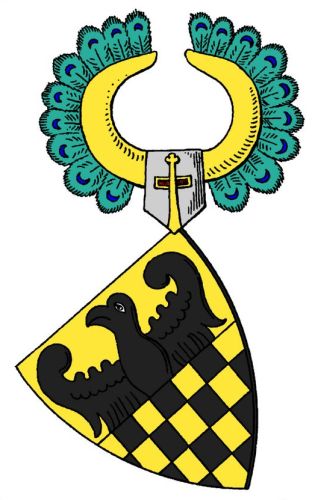
Coat of arms of Henning Podebusk. He came from Rügen. He came into the service of Valdemar Atterdag in 1350. He became gælker in Scania and soon after drost. When Valdemar left the country in connection with the Second Hanseatic War, he became the chief general of Denmark. He led the peace negotiations in Stralsund in 1370. He was among the first to support Margrete in 1375, and he secured her power upon Oluf's death in 1387. Henning Podebusk was a very skilled negotiator, who was always able to find a little less ambitious solution. He managed to be 70 years old, which was a very old age in the Middle Ages. He died around 1388 and is buried in Sorø Monastery Church. Photo: Det Kongelige bibliotek, Billedsamlingen.
When, in August 1376, she had Oluf to confirm the privileges of the Hanseatic Towns in the kingdom, together with the drost Henning Podebusk and the kansler, Bishop Niels of Roskilde, it was said "our and our kingdom's drost" and "our and our kingdom's kansler" . Later she always had them referred to as "our drost" and "our chancellor", occasionally it was said that Henning Podebusk was "drost of the famous Oluf, Denmark's King"..
One by one, Margrete cancelled the royal offices, whose functions had otherwise been clearly defined at the Danehof in Nyborg in 1377. Neither Henning Podebusk nor Evert Moltke had successors after their deaths. The gælker of Scania, Tuve Galen, was deposed in 1383, when his conspiracies with the Mecklenburgers came to light, and he too had no successor. On the other hand, there was frequently talked of "the king's officials" and "the king's bailiffs".
In Norway, Drost Ogmund Finnsøn was also demoted from "the kingdoms drost" to "Our drost" and on his death he also had no successor.
Under King Albreckt, Drost Bo Jonsson Grip carried out extensive law enforcement activities, he confirmed judgments and issued fines, and he was referred to as drost and Karl Ulfsson was also referred to as marsk. But Margrete quickly abolished the Swedish royal offices as well.
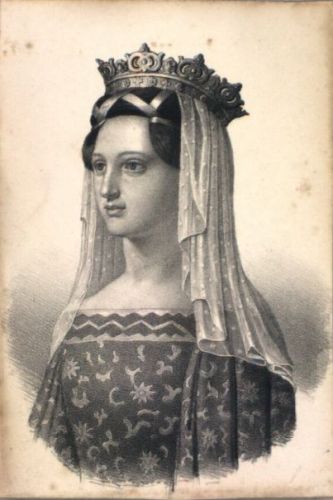
Drawing of Queen Margrete wearing the special veiled crown that she also wears on her tomb monument - unknown artist. Foto: Det Kongelige bibliotek, Billedsamlingen.
In a manifesto issued to the inhabitants of Öster Götaland as early as 1388, neither Sten Bengtsson nor Erik Ketilssson were allowed to retain their titles of marsk. Like the others, they are called "lords", "knights" or "men of the kingdom".
Thus, ignoring historical institutions - such as the Danehof, hand-binding contracts, and the royal offices of gælker, drost and marsk - could probably only be done because she was a woman, who did not arouse the same rival feelings in men that a mature man as king would have done. Furthermore, she was known to be deeply religious and had personal connections with the Swedish saint, Birgitta of Vadstena, who promoted a more prominent role for women in Christendom. Therefore, one can imagine that some were led to believe that her unconventional leadership covered up feminine and Christian goodness.
Detmars Chronicle from Lübeck confirms in 1386 that Margrete worked to centralize and strengthen her power in the three kingdoms: "When this had happened, great anxiety and reluctance arose among all the men in the kingdom, because they learned the lady's wisdom and strength to know and volunteered to serve her and her son. She moved her bailiffs around in the country as an abbot moves monks from monastery to monastery."
Apparently, Margrete feared that her bailiffs would eventually identify too much with the locals and thereby weaken their loyalty to her.
Probably for the same reason, Margrete often appointed German and Danish men to positions in Norway and Sweden, the latter being assumed to be more loyal, owing their position only to her. Thus she appointed a German named Nicolaus Rusare as Archbishop of Nidaros.
She instructed the young King Erik that he should install a certain German named Claus Grubendal as kansler in Norway and Erik had to: "not let anyone have the power to depose or promote him, or take the fiefs from him that he now posseses - except God, yourself and I. For there are some, who do not like him because he is a foreign man".
In Margrete's time, the Danehof was held in 1376 in Slagelse, where Oluf was elected king, in 1377 in Nyborg, and again in Nyborg in 1386, where she gave Southern Jutland to Count Gerhard of Holsten. Since then, Margrete did not call the assembly for any reason. "The Danehof lost its importance" as the historians write.
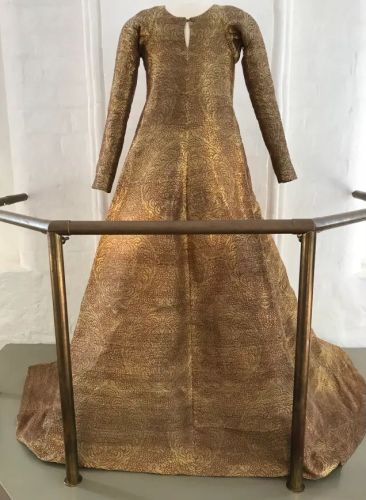
Copy of Queen Margrete 1's wedding dress in Roskilde Cathedral. The original dress was taken as spoils of war by the Swedes in 1659 and taken to Uppsala Cathedral, where it was eventually forgotten. In the early 1900's, however, it was found in a bundle of clothes in the attic. It was then again exhibited in the cathedral, where it stands to this day. New research has shown that the dress is from the beginning of the 1400's century, and it may thus have been worn by the queen in her later years. It is woven in Italy with red and gold threads. A pattern of small pomegranates is woven into the fabric. Foto: Historical Textiles.
On the occasion that the young Erik of Pomerania was to travel to Bergen in 1405 to meet his future wife, the English princess Philippa, Margrete gave him a long letter of instruction in 54 paragraphs, which describes in great detail how he should behave in relation to the people he met on the journey. The document has been preserved to this day. It gives a good illustration of how the queen carefully considered every step she took.
Margrete admonished her adopted son: "Wherever you come, let the common people salute you and swear that with God's help they will keep you as their king by God's grace and do all that for you that they should do for their king. And you must say to those, who do this, that you will secure for them peace, law and justice with all your power, and you must by no means neglect to do so where you travel along." We note that she uses the expression "king of God's grace" like the later autocrats.
Margaret continued: "If someone, cleric or layman, comes to you and asks for some privileges or liberties, letter of salvation or letter of protection - then you must delay it as long as you can. If they want to know your opinion, you must postpone it until I come and say: that you await me daily, as soon as I come you will do it if I advise it, but you can do nothing until I come, for I know more about that than you. And you must let it be like this, you must take good care of whom you give any letter with your seal underneath - the one you wear on a daily basis."
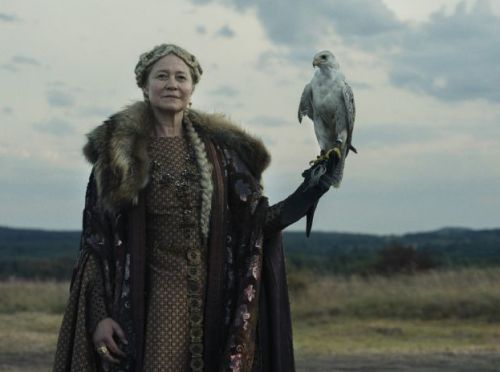
Queen Margretes 1. in the film of the same name with Trine Dyrholm in the role as Margrete. Photo: Scala Gudhjem.
She further admonished:: "You must be careful not to issue too many letters with the seal that you now have on you and not parchment letters with hanging seals. If anyone talks about getting relief from "gengæld" (an extra tax) on paper with a hanging seal, do not let your seal hang below, but let the seal press on the back of such a paper letter.
Historian Vivian Etting explains "that if a letter was less officially designed, it was easier to ignore later, and Queen Margrete has obviously used this trick herself to avoid binding herself in unpleasant situations. One immediately comes to think of the union document, which is precisely made of paper with imprinted seals. So, it is a possible argument that the union clauses did not suit the queen."
As today's queen, Margrete was happy to do needlework in the spare time that she obviously must have had after all. In a description of her burial feast in Roskilde Cathedral in 1413 by the German chronicler Herman Korner it is stated: "The altar cloths were the work of her own hands". - and he also says that there were 50 altars.
Margrete was very active in the efforts to have Birgitta canonised. In 1391, she was able to place Birgitta's bones in the holy shrine in Vadstena after Birgitta had been canonized by the Pope.
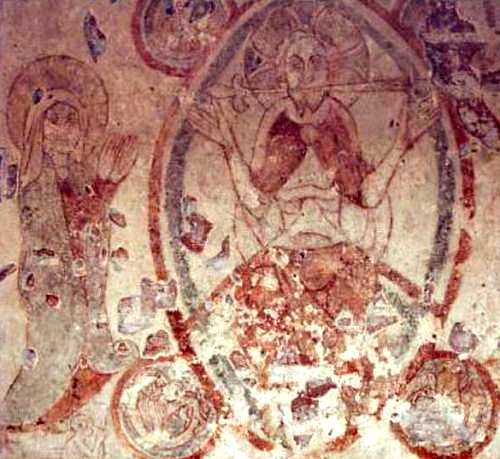
Chalk painting from 1397 in Tirsted Church near Rødby of the Virgin Mary and Jesus, who judge the living and the dead. Foto Kalkmalerier.dk
Since Margrete in her youth wrote her letter to King Håkon that she and her servants "suffered great want of food and drink", she had accumulated immeasurable riches. But she was also a generous regent. Hardly any other Danish ruler has given such large and expensive gifts to churches and monasteries and many other charitable purposes as Queen Margrete did.
In August 1401, Eric of Pomerania, the Nordic archbishops, bishops and the Nordic councelors were gathered for a large meeting in Helsingborg Castle, where they confirmed an incredibly long list of the gifts that Margrete "has given and transferred to churches and monasteries" in Denmark and Sweden.
In 1376, she gave the cathedral in Lund a golden cup, which was studded with precious stones.
In 1407, she gave Børlum Monastery a gold crown, which was set with precious stones. The bishop was obliged to put it on the head of the figure of Mary in Børlum Church on all feast days for the Virgin Mary or other saints. She also donated some golden crowns to the Holy Trinity Festival in Flensborg, which were to be placed on the head of a Maria sculpture on certain occasions. We must believe that this was entirely in accordance with Saint Birgitta's mission to elevate the importance of the Virgin Mary and thus of women in Christendom.
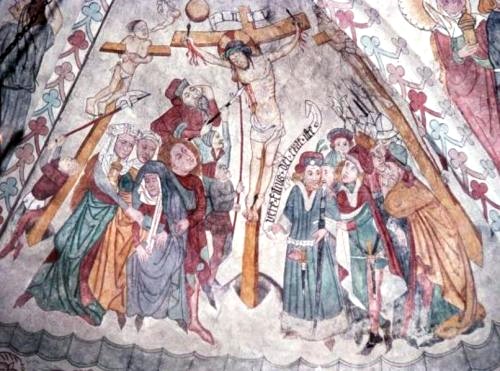
Chalk painting with Jesus on the cross in Tågerup Church north of Roskilde from around 1400, on the left the grieving Virgin Mary. Photo Kalkmalerier.dk
In September 1407, Bishop Eskil of Ribe received 500 mark in return for establishing an altar to Our Lady in the cathedral, where "a sung Mass for the Annunciation must be held every day until Judgment Day".
In the summer of 1393, when the queen attended a royal meeting in Vordingborg, she donated to the church a number of estates and manors, which the crown had seized from rebellious nobles. She was particularly generous to nunneries.
Viborg Bishopric got the castle Hald near Viborg, Børlum bishopric got Rugtved Castle, Roskilde Bishopric got Saltsø Gods, Our Lady Nunnery in Aalborg got the main farm Egholm, Our Lady Nunnery in Roskilde got Kelstrup castle in Odsherred and Hundslund Nunnery in Vendsyssel got several small properties in Northern Jutland.
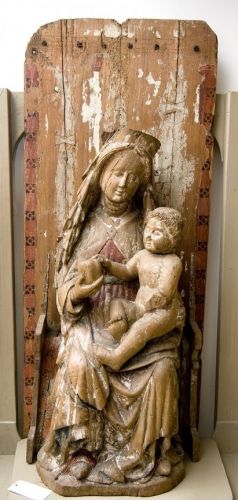
Wooden figure of Mary and the baby Jesus from around 1400 from Annisse Church northwest of Hillerød. It is kept in the National Museum. Photo Leif Tuxen Kristeligt Dagblad
However, she attached conditions to the gifts. The castles were to be "immediately demolished - both of stone and wood" and new altars were to be set up for Masses for the souls of Margrete and her family. There were also very specific conditions - often associated with religious acts in honor to the Virgin Mary. She leaves us in no doubt that for her the Virgin Mary was at least as important as Jesus.
For example, the queen ordered that at the altar in Viborg Cathedral "a sung mass to Our Lady should be held every day until Judgment Day, and while the mass is sung, a candle should be lit", and every year on the second day after the Blessed Virgin Mary was taken, body and soul, into Heaven (August 15) "the bishop must take care of the provost and the priests as best he can with food and beer and the peblings must be treated well that day and they must be given a barrel of beer and a hundred loaves and food with it and they must sing Our Lady's Hymn that is called "Ave Regina caelorum" in the aforementioned Our Lady's Church in front of our Lady's altar."
Our Lady's hymn was in Latin. In the English translation it reads:
Hail, O Queen of Heaven.
Hail, O Lady of Angels.
Hail! Thou root, hail! Thou gate
from whom unto the world, a light has arisen:
Rejoice, O glorious Virgin,
Lovely beyond all others,
Farewell, most beautiful maiden,
And pray for us to Christ.
For other donations, she also prescribed various Maria prayers such as "Ave Maria" and "Salve regina misericodia".
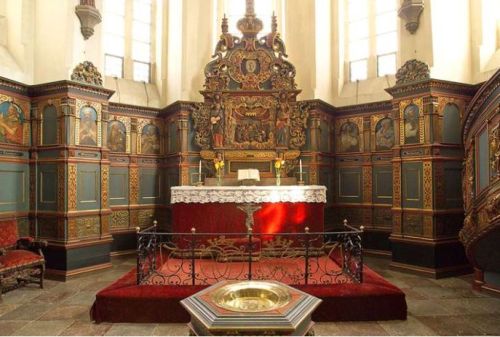
Gavnø Castle Chapel is what remains of the Dominican nunnery that Queen Margrete had built in 1402. However, the very colorful interior was only added in 1670 thanks to Helle Rosenkrantz-Gyldenstjerne, who was married to admiral Niels Trolle. Photo Gavnø Slot.
Queen Margrete had several nunneries established. In 1401 she had a nunnery established for the Dominican Order in Gavnø near Næstved. She gave the Birgittine order a piece of land near the village of Grimstrup, where a Birgittine monastery was built after her death, which gave rise to the place changing its name to Maribo. The monastery church is today the Maribo Cathedral.
She donated considerable estades to Sorø Monastery, Odense Cathedral, århus Cathedral, Linköbing Cathedral, Strangnæs Cathedral, Roma Monastery on Gotland and Our Lady's Monastery in Kalmar.
At the end of 1411, the queen must have known that her life was running out. She gathered a circle of guests at Kalundborg Castle, led by her long-time friend, Bishop Peder Jensen Lodehat of Roskilde, and instructed them to dispose of an enormous sum of 16,337 Lübeck mark. 5,000 should go to "poor churches and monasteries and among Our Lord's people and homeless, who have nothing, and to help poor virgins, women and men to the daily bread for what has happened in the war"..
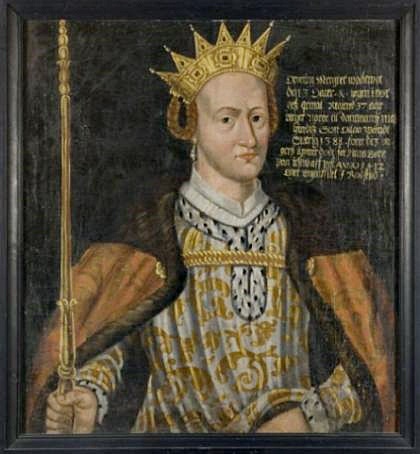
Margrete 1. on old painting at Sweden's National Museum.
Margrete 1. på gammelt maleri på Sveriges Nationalmuseum. The text reads: "Queen Margret Voldemor 3. daughter. The king in Norway's consort reigned 37 years inherited Norway to Denmark with her son Ollao won Sweden 1388. have these kingdom's crown died off Flinbborg on a skio from pest ANNO 1412. Lies buried in Rodskild". Photo Store Norske Leksikon.
Some thousands were to be given to churches and monasteries at Wilsnack "in honor of God, Our Lady and St. Mathias, who made these three kingdoms on Our Lady and St. Mathias Day." We notice that she in Birgitta's spirit mentions God and Our Lady, but not Jesus. St. Mathias Day is February 24, the anniversary of the Battle of Falköbing, on which day Margrete won Sweden.
She also donated money to the women who had been raped in the wars in Sweden. No evidence was required, they simply had to state that they had been raped: "among women and maidens, who you can ask and be told have been violated and degraded in these wars east of the Sound." Something should be paid to "prayers for the souls that have died in these wars both by land and by sea, whether they have been with the kingdom or against."
There is a big quantity of donations for "poor clerks to be helped to school", "clothes, trousers and shoes" for the poor, homeless, poor clerks, destitute virgins, widows and altogether people, "who do not know of any other ways or help."
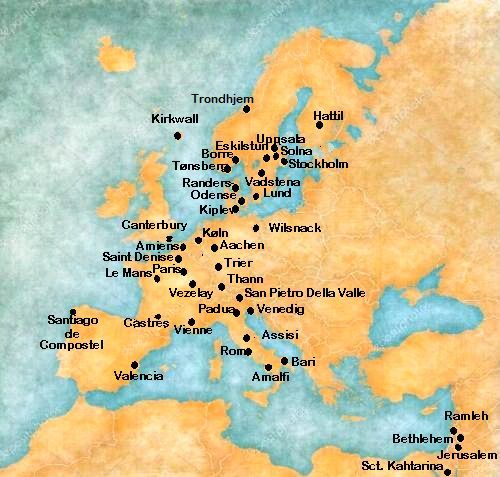
Queen Margrete's pilgrimage destinations. In December 1411, 10 months before her death, she decided that after her death 130 pilgrims should visit a large number of pilgrimage destinations and pray there for the salvation of her soul. The interpretation of the old document has been difficult and the lists of pilgrimage destinations differ quite a bit from each other, and not all are shown here. For some of the destinations, it applies that they should be visited by several pilgrims. For example, Wilsnach and Canterbury were to be visited by three pilgrims each.
Like her father, Valdemar Atterdag, she was aware that as a regent she had made many decisions which were beneficial to the kingdom, but to the detriment of many individuals. She decided that after her death, 130 pilgrims should visit a large number of pilgrimage sites in Europe and the Holy Land and pray there for the salvation of her soul.
Immediately after the news of King Oluf's death in Falsterbo in August 1387 reached Mecklenburg, his cousin and rival, the young Duke Albreckt, assumed the title "Heir to Denmark" at the same time as his new seal with the Danish lions contained the inscription "King of Denmark"..
But this time too he was passed over.
Margrete acted at breakneck speed.

Lindholm castle ruins between Ystad and Malmø. Photo Jorchr on sv.wikipedia Wikiwand.
By complete coincidence, several councilors and other nobles were present in Scania, when Oluf died. They were Drost Henning Podebusk, Margrete's advisor Bishop Peder Jensen of århus, the newly appointed Archbishop Vinald Henriksson of Nidaros, who was on his way home from Rome, the Mecklenburg nobleman Henrik Parow, who had entered the queen's service a few years before, the officials, Folmer Jacobsen, Reimar Breide and Bent Byg, the chieftain of Lindholm Castle Jacob Mus, the Scanian nobleman Stig Pedersen Krognos, the knights Otto Jensen Markmand, Henning Olufsen, Albert Vind and young Kurt Moltke.
Together with the queen, these men agreed to postpone a new royal election and appoint Margrete as regent. We can believe that the queen's regular supporters, drost Henning Podebusk and Bishop Peder Jensen, were the initiators of this decision.
Already a week after Oluf's death, namely on 10 August, she was hailed at the Scania county ting as "the ruler and guardian of the whole kingdom" by "several of the men of the kingdom and of Denmark, prelates, townsmen, farmers and more good men and the congregation of several of Denmark's lands."
About a week later, she was hailed at Ringsted county ting, where, in addition to councilors and other dignitaries, there were "peasants, bokarls and townspeople present and the congregation of Møn, Lolland and other lands." " Bokarls" were rural men who were not owners or holders of land, a kind of farm laborers.
Due to the speed with which the events developed, the other Danish magnates were probably unable to get together and set up hand-binding contracts or other preconditions. With lightning speed, Margrete and her men addressed the common people directly.
Since she was also hailed at Viborg County ting and finally on th island of Fyn.
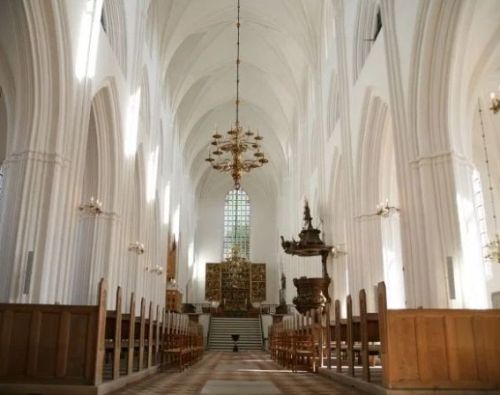
St. Knud's Church in Odense where, according to the historian Vivian Etting, Margrete was hailed in 1387. The construction of the current church in Gothic style was begun in the late 1200's by Bishop Gisico, after an older church had burned down. In 1387, part of the nave of the church was probably finished. However, the church was not consecrated until 30 April 1499. The church tower was added in connection with a rebuilding in the 1580's. Photo Odense Cathedral history.
On Funen, the commanders of the castles Hindsgavl and Nyborg, the county judge, the bishop of Odense Valdemar Podebusk and other clerical and secular councillors, congregations on Funen, Langeland and Tåsinge were present in the main nave of St. Knud's church in Odense, where the meeting is said to have taken place.
At all the events, tribute letters were drawn up, almost identically:
"It must be known to everyone who sees this letter or hears it read that we (here follows a number of witnesses - e.g. from Lund the names mentioned above) testify and acknowledge with this our open letter" - "together with many more of the men of the Kingdom of Denmark, such as archbishops, bishops, knights, journeymen and even more of the men of the Kingdom and ordinary people from all the countries of Denmark - elected, adopted and appointed the honorable princess and lady, Mrs. Margrete, The Queen of Norway and Sweden to the ruler and to the husband and to the guardian of all Denmark."
"First, since the aforesaid Margrete is King Valdemar's daughter and King Oluf's mother, both of whom were our lords, and who are now dead - may their souls be with God - and because of the goodwill and favor that we have experienced and found in her, on many points, we have agreed with her, and she with us, that we shall not take any lord, chieftain or other man as king, and not bring any man into Denmark, and not take any man for help, who in any way is against her, but only with her advice and will to take in any man, and the same she has promised us in return, and we and our friends will follow her for better or for worse. She has promised us that she will let us enjoy fairness and justice and the privileges that her ancestors and her son have given us."
"And we have with our good will and with good advice chosen, appointed and honored her to be our lady, to our husband and to the ruler and guardian of the entire kingdom of Denmark, and we promise to serve her as Danes should faithfully serve their lady, husband and lord, until the day when she and we unanimously agree to choose and get a king and agree to choose a king." - "All these points written before, we have together with several Danish men, archbishops, bishops, knights and journeymen, prelates, townsmen, farmers several good men from several of Denmark's countries promised and sworn to observe."
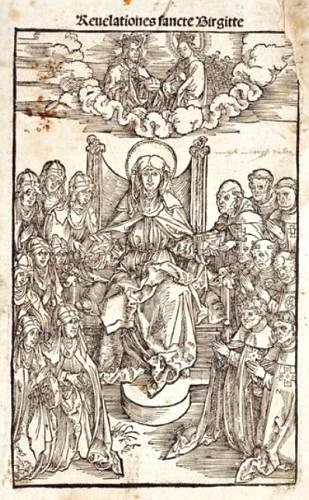
Cover of Saint Birgitta's Revelations, Sancta Birgitta, Revelationes Celestes, from around 1500. Photo Wikitrans.
Margrete must have been quite popular and enjoyed great trust, since she was elected regent of the kingdom in all parts of the country with such ease. But her success must also have been conditioned by the fact that Saint Birgitta's visions of a more prominent role for women in Christendom had already permeated all layers of society.
In the middle of winter - at New Year's time - Margrete set off on a journey to Norway.
On her marriage to King Håkon, she had received large areas in Bohuslen, Vester Götaland and Nørre Halland as a morning-gift, which areas had previously belonged to Duchess Ingeborg, King Håkon's grandmother. The countries mentioned above were the base area for the union of the Norwegian and Swedish royal families under the Folkungs, which were the lineage of Magnus Smek and his son King Håkon.
There is no information that Margrete was present, but just at the time of her journey she was given the castles of Oppensten and Öresten in Vester Götaland by the Swedish commander Algot Magnusson.
In Norway, her case at firt glance seemed to be a little more difficult, because Norway was a hereditary kingdom, and the closest heir was King Albreckt of Sweden because he was the cousin of the late King Håkon. However, everything quickly fell into place without any problems.
The archbishop Vinald Henriksson, who had already paid tribute to Margrete in Lund a few months before, had in the first days of February 1388 convened an assembly in Oslo consisting of Norway's most distinguished clergy and worldly great men. Present were the bishops of Oslo and Stavanger and the newly appointed bishop for Greenland. In addition, there was the Archbishop's brother, Chancellor Henrik Henriksson, who had been in the service of the King of Norway since King Håkon, as well as about 15 secular councillors.

The Kingdom of Norway in 1388 was united with its tributaries in a kind of commonwealth. The skat-lands were the Faroe Islands, Shetland - called Hjaltland, Orkney, Iceland and Greenland. Foto Wikiwand.
At the meeting in Oslo, the assembly, on behalf of itself and the common people, swore an oath of homage to Margrete and issued an open letter to all men throughout Norway and its skat-lands:
"Because that high-born princess, our dear lady, Mrs. Margrete by the Grace of God, Queen of Norway and Sweden, rightful heiress and princess to the kingdom of Denmark, wife of our dear Lord King Håkon and mother of our dear Lord King Oluf, who recently died - May God have both their souls - and for her favor and good will, which we have always found from her and still hope the same from her grace, then we all the aforesaid archbishops, bishops, provosts, knights and journeymen and the entire kingdom of Norway have adopted, chosen and conceived with good will the high-born princess, Mrs Margarete, Queen as aforesaid, to all our aforesaid archbishops, bishops, provosts, knights and journeymen and the entire kingdom in Norway's mighty lady and right husband, and that the aforesaid Queen Margrete shall be fully powerful to preside and advise the kingdom of Norway mighty in all parts over the entire kingdom of Norway, both land and castles and tegner (subjects) both in the south and in the north everywhere in Norway and its skat-lands all the days of her life with God's help, and we all prescribed and individually shall strengthen and help her in all her right and nothing hinder that she have the right to, and all of us the aforesaid archbishop, bishops, provost, knights and journeymen have, on our behalf and on behalf of the whole kingdoms of Norway, said, promised and sworn to her loyal following and faithful service with fidelity as long as she lives, and to keep all the prescribed for her."
In return, Margrete took the royal oath.
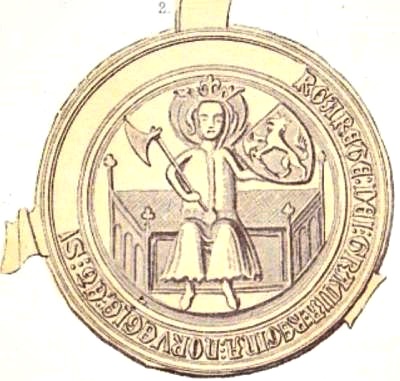
Seal belonging to Queen Margretes 1. as regent of Norway, used 6 March 1388. Text: [s' ma]RGARETA : DEI : GRACIA : REGINE NORVEGIE : ET : SV[ecie ....] Photo drawing by Klevenfeldt ("Norske Herold") - Brinchmann, Chr. "Norske Konge-sigiller og andre Fyrste-sigiller fra Middelalderen" (1924) Wikipedia.
After the ceremony, Margrete should have asked the assembly who would now be the nearest heir to the throne of Norway. Both King Albreckt of Sweden and the young Duke Albreckt were mentioned, but the Norwegians did not want them. Instead, they suggested Duke Vartislaw of Pomerania's five-year-old son, who was the son of Margrete's sister's daughter.
Thus the succession to the throne in Norway was settled long before it happened in Sweden and Denmark.
The young Duke Albreckt of Necklenburg died at about the same time as the meeting in Oslo took place, and he was thus out of the picture. But the assembly did not know that.
The following summer, 1388, Margrete adopted her niece's son, Bugislav of Pomerania, under the name Erik of Pomerania. He was born in 1382 and thus 5-6 years old, when he arrived in the Nordic countries.
Oluf's death in 1387 had with one stroke removed Margrete's legitimate basis for power, as she ruled as guardian of her son. But she acted with lightning speed and after a short time she was recognized as "the ruler and guardian of the entire kingdom of Denmark" and "the whole kingdom of Norway's mighty Mistress and Right Husband"..
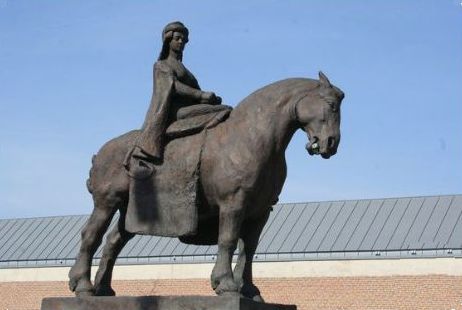
Equestrian statue of Queen Margrete d. 1 on Københavnsvej in Roskilde. Performed by Anne-Marie Carl-Nielsen, who was married to the composer Carl Nielsen. Photo Pinterest.
After that, she was able to turn her attention to Sweden.
Here the situation was that the drost Bo Jonsson had died, and he had bequeathed his enormous fortune to a group of great men consisting of two bishops, five knights - including Saint Birgitta's son, Birger Ulfsson - and three squires. The legacy of Bo Jonsson included approximately half of Sweden including Finland.
But King Albreckt could not let such a fortune pass his nose. Bo Jonsson's widow and children, feeling slighted, authorized the king to act on their behalf, and subsequently he refused to recognize the executors, requesting them to come forward and produce proof of their right to administer the estate. But they held their lives and property dear and did not come to the king.
Instead, they turned to the young King Oluf, King Håkon's son, who was just staying in Scania, perhaps at the beginning of August 1387. But after only a few days - also in August 1387, the 17-year-old Oluf died quite suddenly at the castle in Falsterbo.
Then, in their distress, the board of trustees chose to turn to Oluf's mother and King Håkon's widow, Margrete, who in the meantime had been appointed "Ruler and guardian of the kingdom of Denmark" and "Norway's full ruling lady and right husband".
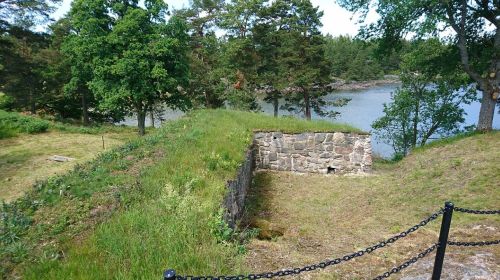
Dalaborg castle ruins, located on a promontory just north of the outlet of the Dalberg Stream into Vänern in Bolstad parish in the current Mellerud municipality in eastern Dalsland. Dalaborg was built in 1304 and destroyed in 1434 during the Engelbrekt feud. Photo Walden81 Wikipedia.
They met at the end of March 1388 at Dalaborg Castle near Vänern. Here, on behalf of the Kingdom, they appointed Margrete as "Sweden's full ruling lady and proper husband". They promised that, sword in hand, they would help the queen take all the houses and fortresses that had belonged to "the royal crown of Sweden".
Those present promised not to make peace with King Albreckt without Margrete's consent. As executors of Bo Jonsson Grip's will, they handed over to Sweden's new "full ruling lady" a number of fiefdoms and castles. It was about Turku, Tavastehus, Raseborg Castle with Nyland, Korsholm - all in Finland, Kastellholm on åland, Hälsingeland, half of Dalarne with iron mines, half of Kopparberg with iron and copper mines and Östergötaland with all market towns and castles.
She was empowered to negotiate on behalf of Sweden with the Holstenians about their share of the copper mines, to negotiate with the Hanseatic League about their privileges and rights in Sweden, and to negotiate with the commander of Kalmar Castle, Vicke von Vitzen.
In the month of May, a further large number of Swedish knights and armsmen declared that they were satisfied with the negotiation protocol and assured the queen of their loyalty.
Margrete assured that the Swedes, who had land in Denmark and Norway could keep it freely. She solemnly promised that the Swedish estates should enjoy "all the liberties and privileges which the king had given them and their ancestors before King Albreckt came to Sweden". She promised to rule the country in accordance with the Swedish laws.
Albreckt tried in vain to collect extraordinary taxes to finance an army, but this only caused the mood in the country to become increasingly threatening against the king and his Mecklenburgers.
But the citizens of Stockholm, who were for the most part Germans, swore allegiance to him. He installed his son, Erik, as regent in his place and went to Mecklenburg to raise an army. His father and brother were both dead, and he himself was Duke of Mecklenburg.
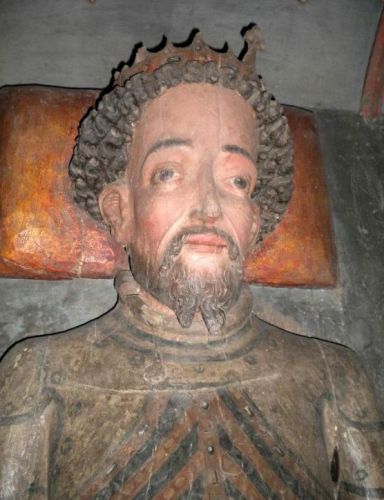
Albreckt of Mecklenburg, King of Sweden, on his contemporary tomb monument in Bad Doberan Monastery Church. Photo Jacob Truedson Demitz for Ristesson Wikipedia.
After a five-month stay in Mecklenburg, he disembarked his army in Warnemünde and went ashore at Kalmar at New Year 1388-1389. The army consisted of experienced, armored horsemen, possibly around 1,000 - 1,500 men, including the Count of Holsten, whose relatives had only three years before sworn eternal loyalty to Denmark in connection with the Holstenian Counts being handed over the Duchy of Southern Jutland as their inheritance dukedom.
One of Margrete's generals, called Niels Svarteskåning, was already besieging the strong fortress Axevalla in Western Götaland near Skara. Albreckt hurried west to rescue the fortress.
Margaret's army was probably gathered from all her lands. It was led by the knight Henrik Parow, who was an able army commander who originally came from Mecklenburg but had defected to Margrete due to unknown disagreements with the old Duke Albreckt of Mecklenburg. According to Detmar, it numbered 1,500 men, probably largely armored horsemen.
Henrik Parow marched north to unite with Niels Svarteskåning's forces at Axevalla. But when Albreckt came to Jönköbing he heard of this, turned and marched directly against Parow's army to prevent it from uniting with Niels Svarteskåning's force.
On 24 February 1389 Parow's army took up position at åsle Kirkeby about 10 km east of Falköping. It is said to have taken a good defensive position with its flanks protected on one side by a swamp and on the other by another impassable area. However, it is difficult to see today.
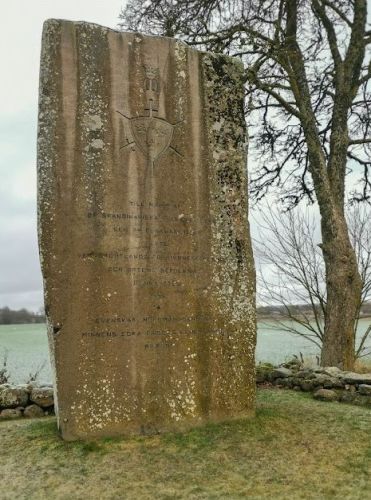
In the town of åsle, near the church, there is a memorial stone for the battle of åsle in 1389, also called the battle of Falköping. It is about a 50-tonne heavy stone, which was set in 1896 and is popularly called "Big Stone". The inscription reads: "In memory of the victory of the Scandinavian peoples on February 24, 1389, Vestergötland's antiquities association and the local population erected this stone in 1896 - Swedes, Norsemen, Danes, in memory of the common feat of the fathers." Photo bmlarsreseblogg.
The Lübeck chronicler, Detmar, believes that Margaret's army won because of the cowardice of some German knights. He describes the battle like this:
"In the Lord's year 1389 on Saint Mathias Day (February 24) there was a big battle at Axevalla in Sweden. The Queen of Norway had sent about fifteen hundred armed men. The chieftain was a knight, whose name was Mr. Henrik Parow. When they arrived at Jömköbing, King Albreckt got the news about this while he was on his way to take Axevalla. So he turned and went towards his enemies, who were Danes and also some Swedes. He had his son with him, his brothers, duke Johan af Stargard's son, who was bishop in Skara, a young gentleman, the count of Holstein and the count of Ruppin. The king was so eager for battle and was so busy that not all of his people had time to prepare themselves. When it came to the actual battle, the king had the first adventure and split two banners. But it didn't last long, and the king lost the battle. He was captured together with the before mentioned gentlemen and all those who were with him on the battlefield, with the exception of those who fled. Among them there was one in particular, whose name was Gert Snakenburg, and he fled on his first day as a knight. He took 60 knights with him in flight, and that was the main reason why the battle was lost. At the time when they were fighting, the queen was at Varberg in Halland. When the news reached her that her army had won the battle, she rode to Bohus. Here she received the gentlemen who had been captured. That same night she had Albreckt tortured so badly that she extortioned him Axevalla and Rumlaborg. She also wanted to extort him in ørebro, but she could not."
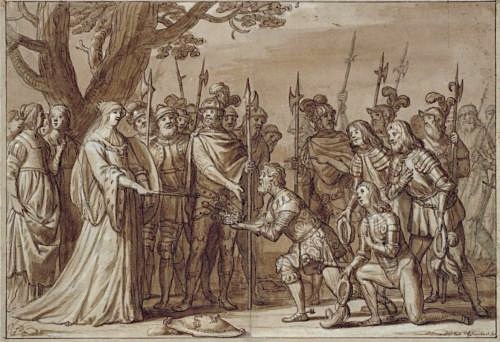
King Albrecht hands over the Swedish crown to Queen Margrete 1. in 1389. Drawing by Gerrit van Honthorst. Photo Statens Museum for Kunst.
In the fall of 1389, Margrete, together with the Swedish Council of State, issued an extra tax on one mark for each peasant, which should pay for "this great war with God's help and her grace's help may have a good and quick end, and peace can come over the land, and every man by the right law of the land can live by his own." At the same meeting, Margrete promised to give 10,000 marks to churches and monasteries in Sweden. At the same time, she promised to fill vacant episcopal seats only with Swedish men.
The Scanian Year Book reports: "On the day of the holy Mathias the Apostle, with the providence and help of God, in whose hand all victory hangs, a great battle took place between King Albreckt of Sweden and the Danes, namely Mr. Parow, chieftain of Norway and Fikke, commander of Kalmar and many others on both sides. King Albreckt of Sweden and his son Erik and Count Gerhard of Holstein and the Count of Reppin with 20 knights and not so few other nobles were taken prisoner, all of whom were sent by the high-born Queen Margrete in captivity in Denmark, namely, the kings in ankle-chains and their nobles in handcuffs. Glory be to God for ever and ever, who gave an unexpected victory in the hand of a woman."
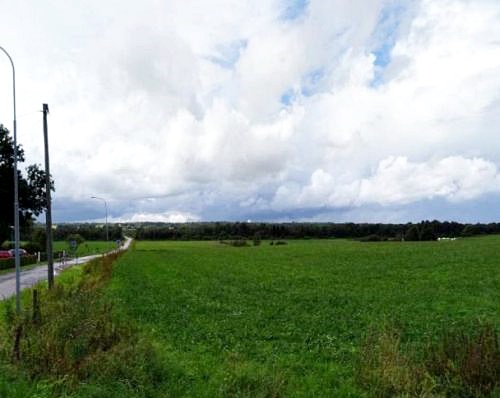
View of the battlefield at åsle. In the background the marsh at åsle, which today is surrounded by trees. As can be seen, the landscape is flat and suitable for cavalry attacks. Photo "Slaget ved Falköbing 1389 - En uventet sejr i kvindens hånd - Nick B. Svendsen.
According to Den Svenske Rimkrönike, 20 Mecklenburgers and 8 Swedish and Danish knights fell, including Henrik Parow himself. King Albrecht, his son, Erik of Mecklenburg, the bishop of Skara, Rudolf of Mecklenburg, and many other knights were captured and taken in chains to Bohus. The commandant at Kalmar Castle, Vicke von Vitzen, probably also fell, in any case the history no longer tells about him, and only his sons are mentioned in connection with Kalmar.
During the battle, the queen stayed at Varberg Castle. When she got word of the victory, she decided that the prisoners should be taken to Bohus, which we can believe had bigger and better dungeons. She herself rode to meet the prisoner transport and continued to Bohus.
Most of the prisoners were quickly released, presumably for ransom. But King Albreckt and his son were by far the most important prisoners, and three days later they were taken to the castle of Lindholm in Scania between Malmø and Ystad and placed in a "high and deep tower".
Margrethe had won the Battle of Falköping 1389, but the Mecklenburgers still controlled Kalmar and Stockholm.
In Kalmar sat the sons of the Mecklenburger Vicke von Vitzen. Their father had given a loan to the Swedish crown and therefore had Kalmar Castle as a pawn. Margrete succeeded in redeeming the castle during 1390. It is said that one of Vicke von Vitzen's sons, whose name was Claus von Vitzen, undertook to mediate between the queen and the city council. The town paid tribute to Margrete and promised to serve her and her descendants - much to the chagrin of Kalmar's many German inhabitants. It is said that Claus von Vitzen left the city "despised by God and man."
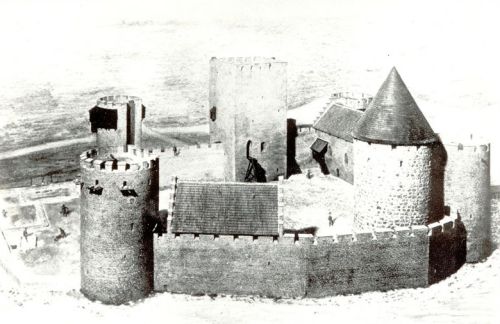
Kalmar Castle in the Middle Ages. The model can be found at Kalmar Castle. Photo Kalmar Läns Museum.
The queen appointed the Dane, Holger Jensen, as commander in Kalmar.
But Stockholm represented a bigger problem. The city was virtually impregnable, located only on Stadsholmen, Riddarholmen and Helgeandsholmen, protected by high walls and water on all sides. It was really impregnable.
Stockholm was a very important city for the Hanseatic cities. The majority of the city's inhabitants were Germans, who had recently sworn allegiance to King Albreckt and his son, Erik.
The German part of the citizens completely took over the power in the city. They formed a company called "die Kapuzenbruder", which means "The hooded brothers", they dressed up as soldiers and went around in the streets at night harassing and humiliating the Swedes that they encountered. It often developed into bloody fights.
The hooded brothers and the city government entered into a conspiracy and the night after Trinitatis, Sunday 13 June 1390, they took action. All leading Swedish citizens were seized in their homes by armed men and taken to the castle, where they were accused of treason and imprisoned. Those who had sought refuge in churches and monasteries were dragged out and taken to the castle, where they were tortured with saws to make them confess their treachery.
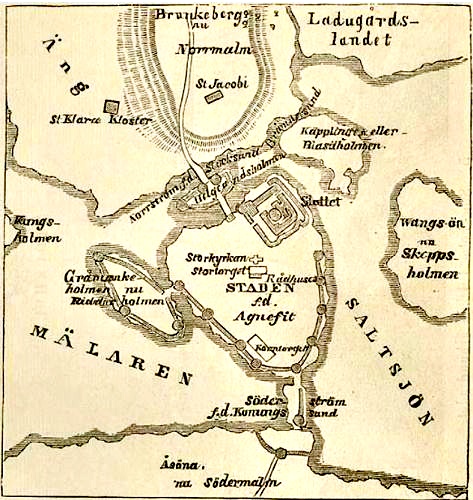
Stockholm in the Middle Ages. Käpplingeholmen can be seen to the northeast. Photo Hedniska Tankar.
The next day, the Germans burned three of the prisoners on the stake. The hooded brothers offered the castle bailiff, the Mecklenburger Herbert Konigsmark, half of the prisoners' property in exchange for him getting rid of the rest. On the night between 16 and 17 June 1390, they were taken over to Käpplingeholmen, which is now called Blasieholmen, and burned in a wooden house. A fairly reliable source tells us that the Germans: "here tied them to an old house, set fire to the house and thus burned them without law or justice, at night, while the people were sleeping."
Another 300 Swedes escaped being expelled from the city.
The Queen's troops surrounded the city in 1391 but found it very difficult to capture it. It also proved very difficult to completely stop the supply of food to the city from the seaside.
The cities of Rostock and Wismar announced that their ports would be open to all "who on their own adventure would fight the kingdom of Denmark".
The privateers or pirates that they were soon to develop into, called themselves the Vitalie-, Viktualie- or Fetalje brothers, which terms all mean food or provisions, because their brotherhood had originally been formed to supply Stockholm with food.
In a very short time they developed into bloodthirsty and brutal pirates who did not distinguish between Danish and German ships or any other nation's ships. Detmar writes that "an unruly crowd of nobles, citizens, artisans and peasants gathered from everywhere who wanted to try their luck"
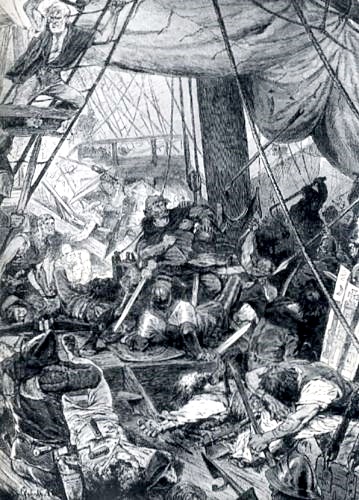
Simon of Utrecht defeats the pirates at the Battle of Heligoland in 1401 and captures the notorious pirate Klaus Störtebeker. Simon of Utrecht was a captain from the Hanseatic city of Hamburg. Photo Seebeer Hamburger Staatsarchiv German Wikipedia.
All kinds of adventurers and shady elements flocked to Rostock and Wismar. The pirates attacked and plundered Danish and Norwegian ships, Belgian ships and even their own Mecklenburg ships. They ravaged Gotland and Bornholm, and the trade of the Hanseatic cities on the Baltic Sea was disturbed to such an extent that they had to abandon their trade on Scania for three years. Detmar writes that very quickly they ravaged "the whole sea and all the merchants and robbed from both friend and enemy, so that the journey to the Scania market was stopped for three years, therefore the herring became very expensive in these years."
The Mecklenburger towns called for a boycott of Denmark and Norway. But the other Hanseatic cities were not in the mood to stop this trade at all. They wrote to the Mecklenburger towns in June 1391: "You have informed us that you have opened your ports to all who want to fight the kingdom of Denmark on their own adventure, but this seems to us very unfair and inconvenient to all the merchants, who in these matters are friends of both sides, and have nothing to do with your war."
In August 1391 the Mecklenburger Johan of Stargard's son succeeded in breaking the blockade of Stockholm with a larger fleet loaded with supplies. They captured one of the queen's redoubts. But the Danes took it back very quickly.
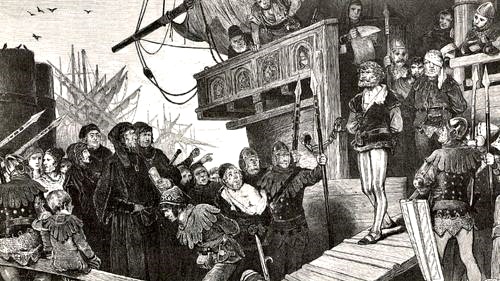
Old copper engraving showing the infamous pirate Klaus Störtebeker being brought ashore in Hamburg for his execution after his capture at the Battle of Heligoland. Photo Hamburger Staatsarchiv.
In October 1391, there were peace negotiations in Nykøbing, which did not produce any results other than an agreement to meet again the following year.
All the while, the Vitalie brothers continued their plundering. Their ships were commanded by Mecklenburg noblemen, while the crews were a confluence of people from all over. They fought under the slogan "Friends of God - enemies of the whole world". During the herring market in Skanør, they attacked a large merchant fleet, which they plundered without regard to the ships' hometowns. Goods from Lübeck were freely unloaded at the wharves in Wismar and Rostock. The Vitalie brothers captured entire ship crews, which they often threw overboard or stuffed into herring barrels and closed them with a lid.
In the summer 1392 there was another peace meeting, this time at Vordingborg Castle. The Queen was present together with ministers from both Denmark and Sweden. Also participating were representatives of the Hanseatic States, the Mecklenburg princes, Duke Gerhard of Slesvig, Counts Claus and Herman of Holsten and Duke Vartislav of Pomerania.
Margrete was a very tough negotiator and peace conditions were tough. In return for King Albreckt's release, Stockholm and everything else Albreckt owned in Sweden had to be handed over to the queen as a pledge for a ransom of 50,000 marks. It was not supposed to be possible to redeem the pledge until after the queen's death, and Albreckt had to promise that he would never again wage war against Denmark, Norway or Sweden. But the negotiations broke down and led to nothing. The queen retained her trump, which was Albreckt and his son, who now were prisoners of the fourth year.
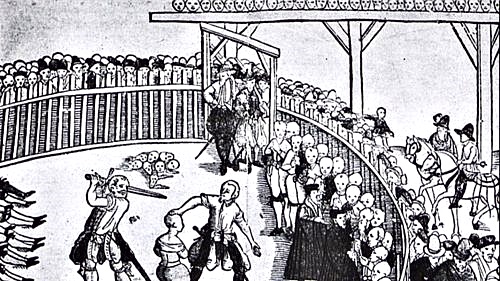
Old woodcut in Hamburger Grasbrook showing beheading of captured pirates. Photo Hamburger Staatsarchiv.
The fight against the pirates developed into a kind of civil war in the Hanseatic League. The city of Stralsund waged an uncompromising war against the pirates. Some merchants from this town succeeded in capturing about a hundred Vitalie brothers in the waters off the town. Using the pirates' own method, they stuffed them all into herring barrels and put the lids on after cutting holes for the heads. The prisoners were first pulled out of the barrels on the market square in Stralsund and each one immediately beheaded.
In 1393 the pirates pushed it so far that they sailed all the way to Bergen, where they looted and burned the city and forced the inhabitants to pay homage to King Albreckt. But after most of the pirates had sailed away, the Norwegians took back power in their city.
Margrete approached the English king Richard 2. and asked him to appoint a suitable bride for her adopted son, Erik of Pomerania. King Ricard allowed the Danes to buy three large English ships for the fight against the pirates and also gave a smaller ship as a gift to the queen.
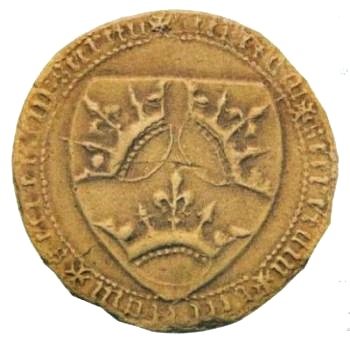
Queen Margaret's seal. The seal is known from documents issued by Margrete between 1391 and 1393. Foto Ukendt/Kari Tarkiainen: Sveriges Österland, side 172 - Riksarkivet, Stockholm.
In the winter of 1394 eight of the Vitalie brothers' ships froze in the ice off Dalarö in the Swedish archipelago on their way to Stockholm with supplies. As they feared attacks from land, they went at night across the ice to land and felled a quantity of trees, which they piled up like a ring wall around the ships. Then they threw water on them, which immediately froze into ice in the intense cold and made the wooden wall hard and slippery and impossible to cross. The carved holes in the ice on the outside of their ice wall.
When the Danes attacked with large siege machines, which were called "cats", the heavy machines went through the ice and the Danes drowned in the icy water, while the Vitalie brothers mockingly shouted "kiss, kiss, kiss". Some time later the weather changed and the ships could sail into Stockholm with their long-awaited cargo.
After six years of more or less constant siege, Margrete finally gave up hope of taking Stockholm by military means.
At the beginning of May 1395 the parts again gathered for negotiations, this time in Skanør and Falsterbo. The result was that Albreckt had to have his freedom for three years until Michaels Mass (September 29) 1398. He had to pay the Hanseatic cities 60,000 marks for his freedom, if he did not pay he had to return to prison and the queen had Stockholm. In the meantime, the city was to be administered by the Hanseatic cities of Lübeck, Stralsund, Greifswald, Danzig, Thorn, Elbing and Reval. The Mecklenburger cities were to contribute to the costs of these cities with 1,000 Lübeck mark per year, Margrete with 2,000 Lübeck mark and Albreckt with 1,000 Lübeck mark each year.
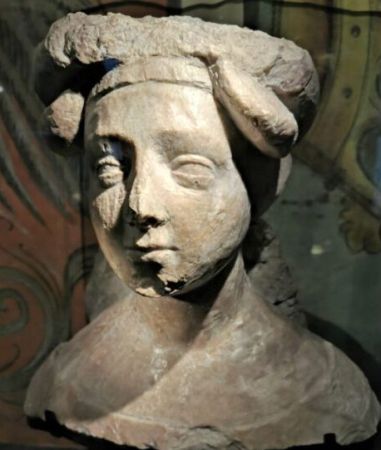
Preparation for the gravestone in Roskilde by the Lübeck artist, Johannes Junge, St. Anne Museum, Lübeck. Many believe that this bust is more similar than the figure on the tombstone in Roskilde. Perhaps it is true, because here one can - with good will - sense something of her father's overbite. Photo Kulturhistorier.
Mecklenburg sealed the treaty with the hanging seals of many magnates, while Margrete never gave the Mecklenburgs a similarly sealed document. Albreckt got a reprieve with his payments to the towns' costs, and perhaps that's why Margrete never paid more than completely insignificant amounts - despite many requests.
It was also decided that Gotland should be divided between the parties so that the queen got the villages and the Mecklenburgs got Visby.
As expected, Albreckt could not pay the huge ransom and on Michaels Mass' Day 1398 Margrete made her entry into Stockholm "She was received there with great solemnity by a large number of people who met and followed her."
In the presence of the queen, on 24 October 1412, the citizens of Flensborg swore a solemn oath of allegiance to King Erik and his mother: "We citizens and councilors and the entire congregation of Flensborg announce" - "that after we now again is to come to the service of our gracious lord, King Erik, and our gracious lady, Queen Margrete and the Kingdom of Denmark" - "and they have now done graciously and well with us, after we have now offended them, then we now offer all ourselves with this our open letter and with our good faith always honest and well to think and serve our dear gracious lord King Erik and and Queen Margrete of the Kingdom of Denmark" - "Would it be so that anyone hereafter, whoever he is, would betray or win the city of Flensborg against this lordship of ours or the Kingdom of Denmark, or often come to us, God forbid, then we should and would all go together and stay together and fiercely resist" - "and which of us does not do that" - "must be judged as a traitor."
The oath that the citizens of Flensborg then took was Margrete's last triumph. She had won back Flensborg, which her father, King Valdemar, had also held after he took Flensborg town with storm in January 1373.
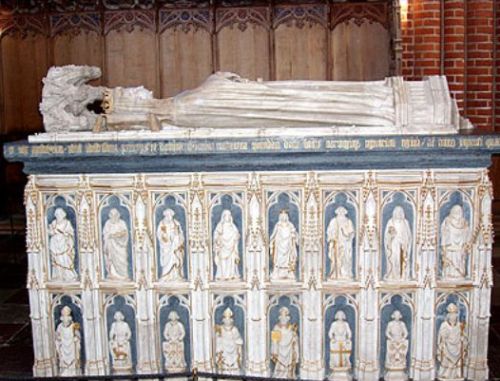
Queen Margrete's tombstone in Roskilde Cathedral. The sarcophagus is from 1423, paid for by Erik of Pomerania 11 years after her death. Photo Wikimedia Commons.
After the oath-taking on the 24, she probably let herself be rowed out to her ship. She probably did not feel well already then, and on the night of 27 October 1412 she died on board the ship in Flensborg Fjord. A German source informs us that she expired while sitting on a chair - perhaps she was working on an altar cloth.
The Holstenian Chronicle writes: "The noted queen, Margrete of Denmark, the origin of all these misfortunes, the ruler of three kingdoms, had, however, at the end of her life, wonderful as it is, not in the vast lands of her kingdoms a single foot of land where she could be allowed to die, but while she was staying on a ship off the city of Flensborg, during a mighty and wonderful storm with lightning and thunder, the soul left her body."
According to her own wishes, Margrete was originally buried in Sorø Monastery with her brother and her beloved father.
But she was not allowed to lie there for long, as her lifelong friend and advisor, Bishop Peder Jensen Lodehat of Roskilde, had the body taken to Roskilde Cathedral - probably in agreement with Erik of Pomerania. All sources say that the body was taken away "almost violently" which probably means that the abductors were accompanied by armed men.
The author of the Danish Rhyme chronicle, brother Niels, puts these words into Margrete's mouth:
If I had had a better friend,
I had stayed in Sorø then.
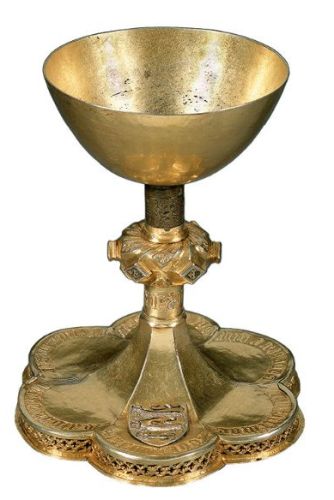
Altar chalice from Krønge Church south of Maribo, which is probably one of the altar chalices that Queen Philippa gave to each of the 50 altars at Queen Margrete's funeral in Roskilde. Photo Lennart Larsson Nationalmuseet.
The Lübeck chronicler Herman Korner reports that King Erik then, at the beginning of July, had the queen's funeral solemnized with the largest church festival that has ever been held in Denmark: "King Erik had a solemn funeral procession held in Roskilde. The following persons participated: Duke Bogislav of Pomerania, Duke Johan of Sachen, the Archbishop of Lund and fifteen other bishops. The festivities lasted for three days. The first feast day was in honor of the recently deceased Queen Margrete and funeral masses were held at 50 altars. From the king each altar received a gilt decoration and from the queen a tablecloth of silk or damask and also a gilt silver chalice. The princes gave a florin to each altar. The knights and the other participants in the feast took as much as they wanted from a bowl filled with Lübeck silver coins and sacrificed it to the altars" - "The altar cloths were the work of her own hands. A more magnificent funeral, with richer gifts to the church of altar cloths, chalices and gold coins, has not been seen anywhere in Europe."
|
Kalkmalerier.dk Kalkmalerier.dk Dronning Margretes nødbrev Arkivverket Kalmarunionen WikipediA Margrete 1 dWiki Totem Michele Batsberg Christensen Slaget ved Falköbing 1389 Nick B. Svendsen Fetaljebrødre WikipediA Vitaliebrødre Historiske Rejser "Den Hellige Birgitta af Vadstena" 1-2 af Johannes Jørgensen - Gyldendal. Danmarks Historie Bind 4 "Borgerkrig og Kalmarunion" af Erik Kjersgård - Politikkens Forlag 1963. "Dronning Margrete" af C. Th. Holbøll - Arne Frost Hansens Forlag. "Margrete 1. En Regent & hendes Samtid" af Vivian Etting - Gyldendal. "Margrete den 1. Nordens Dronning" af Michael Linton - Gyldendal |
| To top |